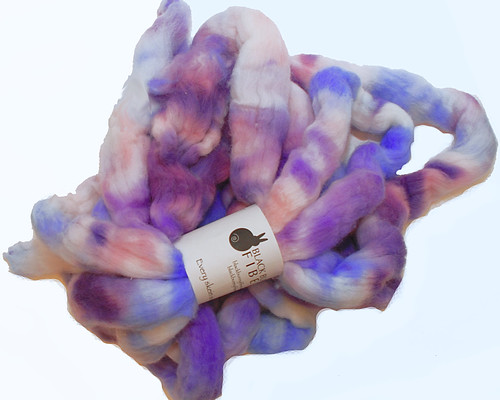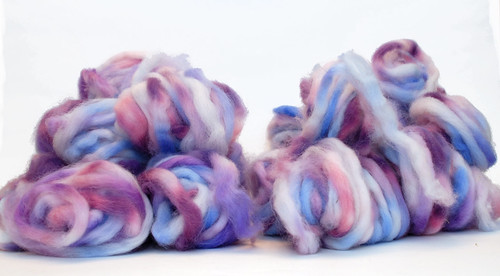This project is actually homework for one of the classes I'm taking at SAFF this weekend.I am required to bring two bobbins halfway filled with tightly spun singles for the class. We are going to learn to create different types of yarn with the singles we bring.So based on that information, I'll be preparing this fiber as if I was going to spin a simple two ply yarn.
 First thing to do is select the fiber. In an effort to be thrifty and save money for festival shopping, I picked something from my stash. This selection is Peruvian Merino wool from the Black Bunny Fiber Club. There is about 8 ounces of fiber in this bundle and the colors is called French Lavender. Color management is not going to be a concern for this project for a couple of reasons. The fiber is dyed in such a way that keeping the colors together would be difficult and I'm using my singles to take to my class so I'm not going to try and get any particular color pattern.
First thing to do is select the fiber. In an effort to be thrifty and save money for festival shopping, I picked something from my stash. This selection is Peruvian Merino wool from the Black Bunny Fiber Club. There is about 8 ounces of fiber in this bundle and the colors is called French Lavender. Color management is not going to be a concern for this project for a couple of reasons. The fiber is dyed in such a way that keeping the colors together would be difficult and I'm using my singles to take to my class so I'm not going to try and get any particular color pattern.So the first goal is to get the fiber divided into two equal piles. I will use each pile to spin one bobbin and assuming that my spinning is consistent; I'll end up with two bobbins that contain very similar yardages. If I was making a 2-ply yarn, this would make plying easy and hopefully I wouldn't end up with a lot leftover on one of the bobbins.
You could go about dividing the fiber a couple of different ways. But I like to do some preparation to the fiber before spinning. Some people refer to this as pre-drafting. You can call it what you want, but it does make spinning easier especially if you are a beginner or if you a trying to spin a very fine thread. Sometimes I do more or less, depending on what I'm hoping to achieve,but I always do some.
 So I start by undoing the braid/bundle of fiber and pulling the long piece into equal halves length wise.I continue to pull the lengths of fiber into even width strips until I have them about the thickness of a pencil roving.You can adjust the width of the strips depending on what you are trying to spin.I would guess that if I took a typical 4 ounce braid of fiber, on average, I would end up dividing it into about sixteen strips.
So I start by undoing the braid/bundle of fiber and pulling the long piece into equal halves length wise.I continue to pull the lengths of fiber into even width strips until I have them about the thickness of a pencil roving.You can adjust the width of the strips depending on what you are trying to spin.I would guess that if I took a typical 4 ounce braid of fiber, on average, I would end up dividing it into about sixteen strips. Once you have all the fiber divided into strips, you can loosen the fibers up by holding the fiber and placing your hands about 4 inches apart. I picked 4 inches for the hand spacing here because I'm using merino and I know the staple length of the merino fibers is usually 3-4 inches. Adjust the spacing between your hands Gently pull the fibers loose but do not separate them completely; you still want the fibers connected in long pieces. You won't have to make as many joins that way. The top strip of fiber has not been pulled apart, but the bottom part shows where the fibers have been opened up for spinning.
Once you have all the fiber divided into strips, you can loosen the fibers up by holding the fiber and placing your hands about 4 inches apart. I picked 4 inches for the hand spacing here because I'm using merino and I know the staple length of the merino fibers is usually 3-4 inches. Adjust the spacing between your hands Gently pull the fibers loose but do not separate them completely; you still want the fibers connected in long pieces. You won't have to make as many joins that way. The top strip of fiber has not been pulled apart, but the bottom part shows where the fibers have been opened up for spinning.If it seems difficult to pull the fibers apart easily; try loosening your grip. it is much easier to accomplish if you do not hold on tightly to the fiber. This is the step I most often skip. Although this step helped me the most when I wast just beginning to learn how to spin. I was able to concentrate more on what to do with the wheel and less about the fiber itself.
 Anyway, once all the fibers are loose and ready to go, I wrap each strand into a separate ball around my hand and pile them up. Wrapping the fiber around your hand will introduce a small amount of twist and help hold the fibers together until you are ready to spin.I use a kitchen scale to weigh all the fiber and then I divide everything into two equal piles and start spinning.
Anyway, once all the fibers are loose and ready to go, I wrap each strand into a separate ball around my hand and pile them up. Wrapping the fiber around your hand will introduce a small amount of twist and help hold the fibers together until you are ready to spin.I use a kitchen scale to weigh all the fiber and then I divide everything into two equal piles and start spinning. I've finished spinning the singles for my class and they came out okay. I'll be sure and share the results of the class and show any yarns that result. Maybe I'll have some singles leftover for a 2-ply as well.
I've finished spinning the singles for my class and they came out okay. I'll be sure and share the results of the class and show any yarns that result. Maybe I'll have some singles leftover for a 2-ply as well.

























11 comments:
I'm looking forward to seeing what they have you do with this in the class.
Wow - that's stuff I've never read in any of the books I have. It's probably in there - but not in language like that!!
This is going to develop into something really nice. I hope the feel is as good as it looks.
Great post. Thanks so much! After seeing some pencil roving, that's how I prepped my first Targhee fiber (nearly halfway spun right now). I've been doing on a honkin' Lacis spindle, but it's working out okay so long as I don't put too much fiber on the spindle. I've noticed that all the pre-drafting makes for seriously fast spinning, even on a spindle.
Thanks so much for posting about other parts of the spinning process. It's really interesting, and exceptionally useful. :o) Now, if the spindle I ordered today from Spunky Eclectic would get here tomorrow . . . lol
Very interesting! I "prep" my fiber completely differently. I'll have to try this on my larger batches or more unevenly colored fiber.
Great step by step. That's pretty much how I do it when I prepare for my drop spindle. Thanks for the tip about weighing the bundles to get a good match up. Can't wait to see them plied.
The way you showed how to is great. Love the colors :)
Ricky
Have fun at SAFF this weekend!
Beautiful work! I wonder how the class went? I signed up for the hand-painted roving class, which I hoped would be more about how to spin it than how to dye it, but it was the latter, not the former. I wish I'd signed up early enough for some of the other spinning classes, and would like to hear more about yours!
Just love all your pics, thanks for sharing!
:)Great information!
Post a Comment